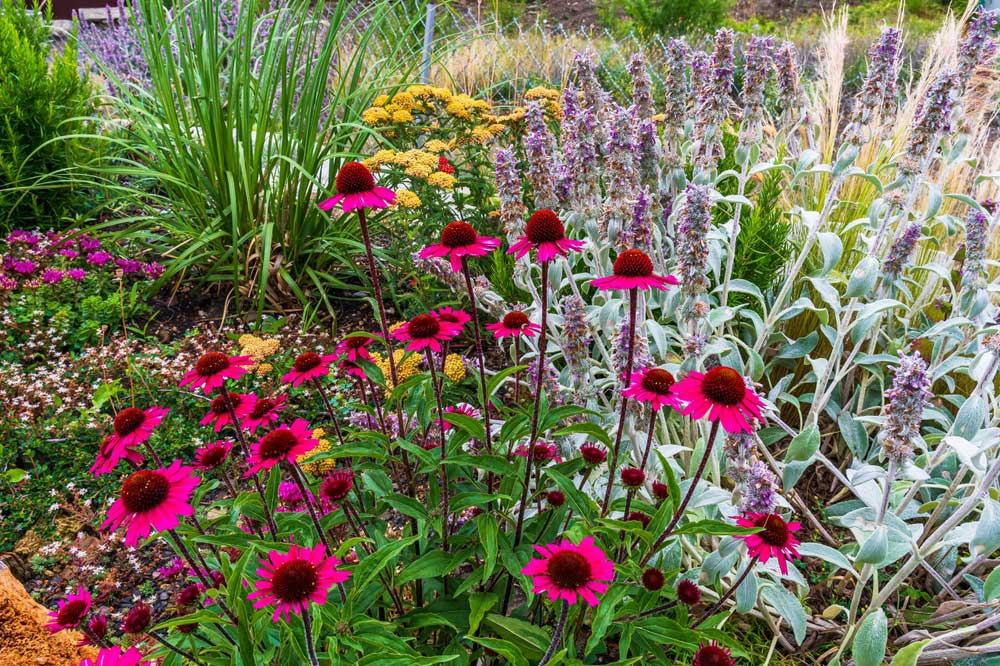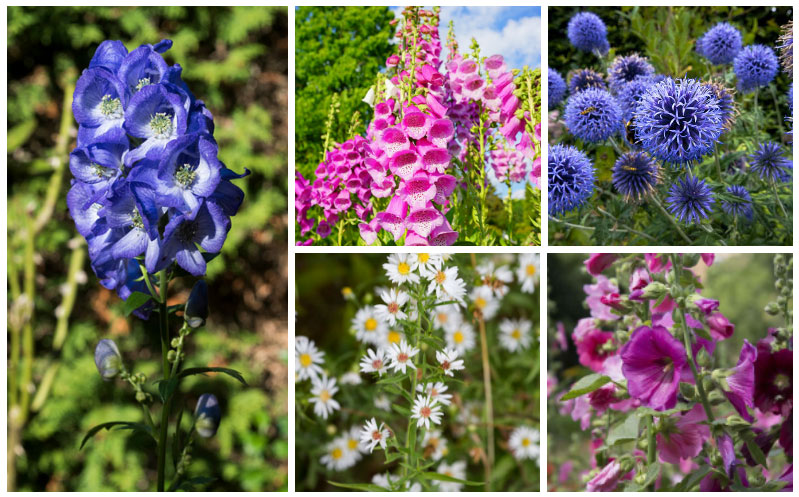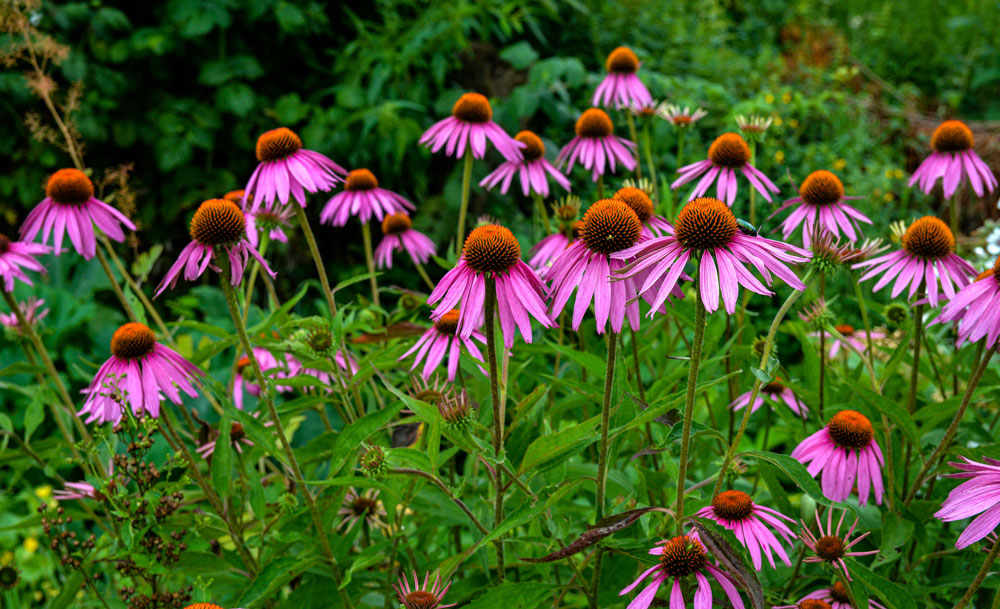
As the fall season approaches, it offers a unique opportunity to enhance your garden with plants that support pollinators. By selecting the right native species, you can create a vibrant ecosystem right in your backyard.
Encouraging the presence of beneficial insects and birds is crucial for maintaining biodiversity and ensuring healthy plant growth. These native plants are specifically adapted to local climate conditions, making them a sustainable choice for your garden.
1. Zinnia

Zinnias are vibrant and easy-to-grow flowers that can transform your garden into a pollinator’s paradise. These eye-catching blooms are known to attract bees, butterflies, and hummingbirds, making your fall garden lively.
You can enjoy a wide range of colors, from red to yellow, pink, and purple. Plant zinnias in sunny locations with well-drained soil for best results. Remember to deadhead them to encourage continuous blooming throughout the fall season.
2. New England Aster (Symphyotrichum novae-angliae)

Consider planting New England Aster in your garden to invite pollinators. Its vibrant purple flowers bloom late into the fall, providing important nourishment. You’ll notice bees and butterflies flocking to this stunning plant.
Make sure to provide it with plenty of sunlight and well-drained soil. This resilient perennial can adapt to various conditions. Enjoy a colorful and lively garden with these blossoms attracting helpful visitors.
3. Black-Eyed Susan

Black-Eyed Susan is a vibrant addition to your garden that draws pollinators like bees and butterflies. You’ll love how its golden petals and dark centers create a striking pop of color in the fall landscape. These flowers thrive in various soil types, making them easy to grow. Consider planting them in sunny spots to maximize their bloom.
4. Coneflower (Echinacea purpurea)

Purple Coneflower brightens your autumn garden with its vibrant blossoms. It attracts bees, butterflies, and other essential pollinators to your space. This hardy plant requires minimal maintenance.
Growing in various soil types, it offers versatility for different garden conditions. Its bold, rich color can become a focal point in your garden. Enhance your outdoor sanctuary while supporting beneficial wildlife.
5. Bee Balm (Monarda didyma)

Bee Balm, also known as Monarda didyma, is a vibrant, eye-catching plant that pollinators love. When it blooms, you’ll notice its bright red or pink flowers, which attract bees and butterflies alike.
This perennial plant thrives in sunny spots with well-drained soil. It’s an excellent choice if you’re looking to add a pop of color to your garden during fall. Plus, it has a lovely minty aroma!
6. Blue Mistflower (Conoclinium coelestinum)

Consider planting Blue Mistflower in your garden to welcome pollinators in the fall. Its fluffy blue blooms add charm and attract butterflies and bees. Known for thriving in moist conditions, it spreads easily and can quickly cover ground areas. Enjoy the burst of color while supporting the local ecosystem and bringing in valuable pollinator species.
7. Sneezeweed (Helenium autumnale)

Sneezeweed adds vibrant color to your fall garden, attracting a variety of pollinators. Its bright yellow or orange blooms are a delightful sight, providing nectar for bees and butterflies. Despite its name, Sneezeweed doesn’t cause sneezing; the term stems from its historical use in snuff.
You can enjoy this low-maintenance plant in sunny spots with well-drained soil. It thrives in gardens, offering both beauty and ecological benefits during the autumn months.
Importance of Native Plants in Pollinator Conservation
Native plants play a crucial role in sustaining ecosystems by providing food and habitat for pollinators, and they are essential in supporting local wildlife’s ecological balance. By planting these species, you can actively contribute to preserving biodiversity.
The Role of Native Plants in the Ecosystem
Native plants offer a stable source of nectar and pollen for pollinators. They have evolved alongside local insect populations, creating symbiotic relationships essential for survival. These plants are adapted to the local climate, making them resilient and low-maintenance choices for gardens or restoration projects.
They help combat soil erosion and improve soil health through deep root systems. Native plants contribute to water conservation by requiring less irrigation than non-native species. You support ecosystem health and sustainability by nurturing native plants in your garden or community space.

How Native Plants Support Local Wildlife
Local wildlife, including birds, insects, and mammals, rely on native plants for nourishment. Many pollinators have specialized relationships with specific native plants. For instance, monarch butterflies primarily feed on milkweed species.
When you plant native flora, you create a welcoming environment for various wildlife to thrive. Native plants also offer essential cover and nesting materials for birds and small mammals, contributing to their survival. You encourage a balanced and thriving ecosystem by promoting native plants, enriching local biodiversity.
Selecting the Right Native Plants for Fall Pollinators
Choosing native plants is crucial for supporting local pollinators. These plants are better adapted to your region, making them more efficient at attracting and nurturing various pollinator species during the fall.
Understanding Your Local Pollinators
Knowing which pollinators frequent your area helps in selecting the most suitable native plants. Bees, butterflies, and hummingbirds have different preferences. Bees are often attracted to flowers with open shapes like sunflowers and asters. Butterflies might gravitate towards brightly colored plants such as goldenrods. Understanding these preferences allows you to create a more effective pollinator-friendly environment.
Consider the specific needs of your neighborhood’s pollinators. Different pollinators are active at various times, so a mix of early and late-blooming plants ensures your garden stays inviting.
Tips for Choosing the Best Plants
When choosing plants, native species are key. They naturally thrive in your climate, requiring less maintenance. Look for plants that bloom in the fall, such as New England asters, goldenrods, and milkweeds. These species offer essential nectar sources during cooler months.
Always opt for a variety of flower shapes and colors. Vibrant hues can attract pollinators from a distance. Choose plants with different heights and spacings, creating an inviting habitat. By ensuring diverse plant selections, you provide not just food, but shelter and protection for pollinators as well.













